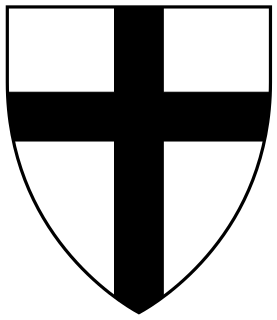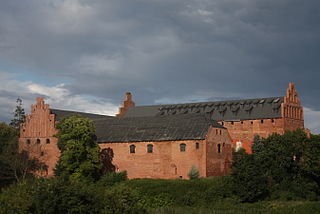
Royal Prussia or Polish Prussia was a region of the Kingdom of Poland from 1466 to 1772.

Malbork is a town in northwestern Poland in the Żuławy region, with 38,478 inhabitants (2006). Situated in the Pomeranian Voivodeship since 1999, it was previously assigned to Elbląg Voivodeship (1975–1998). It is the capital of Malbork County.

Bytów(listen) (Kashubian: Bëtowò; German: Bütow is a town in the Gdańsk Pomerania region of northern Poland with 16,888 inhabitants. Previously in Słupsk Voivodeship, it is the capital of Bytów County in Pomeranian Voivodeship.

Bartoszyce(listen) is a town on the Łyna River in northeastern Poland with 25,621 inhabitants. It is the capital of Bartoszyce County within the Warmian-Masurian Voivodeship.

Ostróda is a town in Ostróda County in the Warmian-Masurian Voivodeship in Poland, with 33,191 inhabitants as of December 31, 2009.
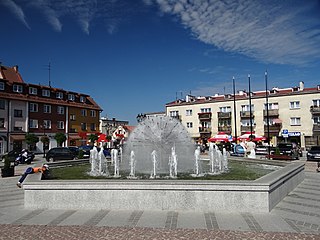
Lubawapronounced [luˈbava] is a town in the Warmian-Masurian Voivodeship, Poland. It is located in Iława County on the Sandela River, some 18 km (11 mi) southeast of Iława.
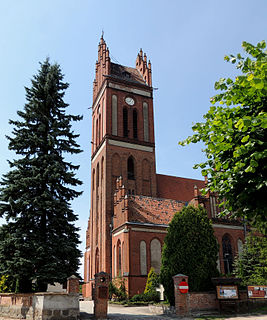
Pieniężno is a town on the Wałsza River in the Warmian-Masurian Voivodeship in Poland. It is located in Braniewo County and had a population of 2,975 in 2004.

Brześć Kujawski, often anglicized to Kuyavian Brest, is a town in the Kuyavian-Pomeranian Voivodeship of Poland. Once a royal seat of Kuyavia, the town has been the seat of one of two small duchies into which Kuyavia has been temporarily divided. According to a census done on 31 December 2010, the town has a population of 4,603.

Ordensburgs were fortresses built by crusading German military orders during the Middle Ages. The term "Ordensburgen" was also used during Nazi Germany to refer to training schools for Nazi leaders.

Dobrzyń nad Wisłą is a town in the Kuyavian-Pomeranian Voivodeship, Poland. It lies on the Vistula River in the vicinity of Włocławek. As of 2004 the town had a population of 2,400.

Węgorzewo is a tourist town in the Warmian-Masurian Voivodeship, Poland, not far from the border with Russia's Kaliningrad Oblast. It is the seat of Węgorzewo County. Lake Mamry is close to the town.

Biskupiec(listen) is a town in the Warmian-Masurian Voivodeship in Poland. It is located in Olsztyn County and has a predominantly Catholic population of approximately 11,400. The countryside surrounding Biskupiec is a popular tourist destination, part of the Masurian Lake District.

Znamensk is a rural locality in Gvardeysky District of Kaliningrad Oblast, Russia, located on the right bank of the Pregolya River at its confluence with the Lava River 50 kilometers (31 mi) east of Kaliningrad. Population: 4,036 (2010 Census); 4,302 (2002 Census); 4,570 (1989 Census).

Dzierzgoń is a town in the Pomeranian Voivodeship in Poland. It is located in Sztum County east of Malbork and south of Elbląg on the river Dzierzgoń. Dzierzgoń has a population of 5,800, while the city and its environs have a combined population of 10,000.
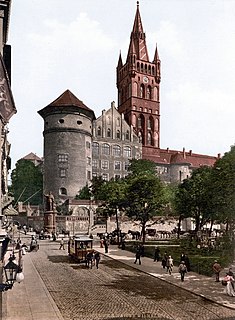
The Königsberg Castle was a castle in Königsberg, Germany, and was one of the landmarks of the East Prussian capital Königsberg.

Ryn is a town in Poland located 19 km southwest of Giżycko, in the Warmian-Masurian Voivodeship. Until the reorganization of 1999 it had been assigned to Suwałki Voivodeship. It had a population of 3,062 inhabitants as of December 31, 2004.
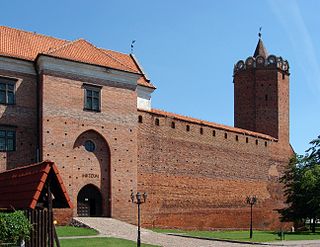
The Łęczyca Royal Castle is a medieval castle situated in Łęczyca, Poland. The castle was erected by Casimir III the Great as a fortification during 1357-1370.

Toruń Castle or Thorn Castle is a 13th- or 14th-century castle of the Teutonic Order located in Toruń (Thorn), Poland. The Castle is part of the Medieval Town of Toruń, one of the World Heritage Sites in Poland.

The Castle of Warmian Bishops is a fortified castle from the 14th century located in the town of Lidzbark Warmiński, Warmian-Masurian Voivodeship, Poland. It is one of the most precious Gothic structures in the country and a popular destination for holidaymakers.

Nidzica castle is a 14th-century castle located in Nidzica, Poland.


